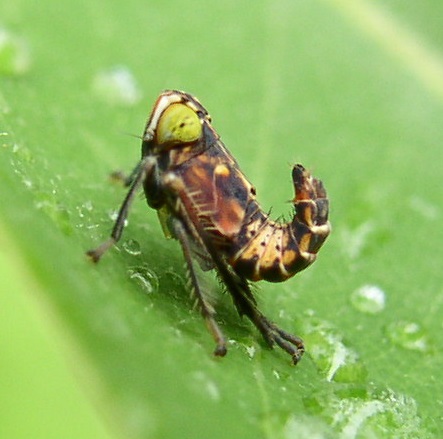|
Achilus
''Achilus'' is the type genusFLOW ''Achilus'' Kirby, 1818 [type genus] (retrieved 22 January 2022) of planthoppers of the family Achilidae. This may be a monotypic genus containing the type species ''Achilus flammeus''.Kirby, 1818: which is the "red fingernail bug" and found in Australia. The placement of ''A. cixioides'' Spinola from Chile, is uncertain, but it may belong in ''Mnemosyne (planthopper), Mnemosyne'' Stål, 1866 (Cixiinae}. The genus described by William Kirby (entomologist), William Kirby in 1819.Kirby W (1819) ''A description of several new species of insects collected in New Holland by Robert Brown, Esq. F.R.S. Lib. Linn. Soc. Transactions of the Linnean Society of London'' 12(2): 454-482. ...
|
Achilus Flammeus
''Achilus flammeus'', the red fungus bug, is a planthopper native to Australia, and accidentally introduced into Auckland, New Zealand. References Hemiptera of Australia Hemiptera of New Zealand Taxa named by William Kirby (entomologist) Insects described in 1818 Achilidae {{Fulgoromorpha-stub ... [...More Info...] [...Related Items...] OR: [Wikipedia] [Google] [Baidu] |
Achilidae
Achilidae is a family of planthoppers, sometimes called "achilids" in the order Hemiptera Hemiptera (; ) is an order of insects, commonly called true bugs, comprising more than 80,000 species within groups such as the cicadas, aphids, planthoppers, leafhoppers, assassin bugs, bed bugs, and shield bugs. They range in size from .... There are at least 520 described species in Achilidae. Subfamilies and genera ''Fulgoromorpha Lists on the Web (FLOW)'' includes 3 subfamilies: Achilinae Authority: Stål, 1866 - 2 tribes ;Achilini Stål, 1866 *Achilina Stål, 1866 # '' Achilus'' Kirby, 1819 - type genus # '' Flatachilus'' Fennah, 1950 # '' Olmiana'' Guglielmino, Bückle & Emeljanov, 2010 # '' Ouwea'' Distant, 1907 *Cixidiina Emeljanov, 1992 # †'' Angustachilus'' Lefebvre, Bourgoin & Nel, 2007 # '' Cixidia'' Fieber, 1866 *Elidipterina Fennah, 1950 # '' Booneta'' Distant, 1907 # '' Catonidia'' Uhler, 1896 # '' Elidiptera'' Spinola, 1839 # '' Faventilla'' Metcalf, 1948 # ' ... [...More Info...] [...Related Items...] OR: [Wikipedia] [Google] [Baidu] |
Type Genus
In biological taxonomy, the type genus (''genus typica'') is the genus which defines a biological family and the root of the family name. Zoological nomenclature According to the International Code of Zoological Nomenclature, "The name-bearing type of a nominal family-group taxon is a nominal genus called the 'type genus'; the family-group name is based upon that of the type genus." Any family-group name must have a type genus (and any genus-group name must have a type species, but any species-group name may, but need not, have one or more type specimens). The type genus for a family-group name is also the genus that provided the stem to which was added the ending -idae (for families). :Example: The family name Formicidae has as its type genus the genus ''Formica'' Linnaeus, 1758. Botanical nomenclature In botanical nomenclature, the phrase "type genus" is used, unofficially, as a term of convenience. In the '' ICN'' this phrase has no status. The code uses type specimens ... [...More Info...] [...Related Items...] OR: [Wikipedia] [Google] [Baidu] |
Planthopper
A planthopper is any insect in the infraorder Fulgoromorpha, in the suborder Auchenorrhyncha, a group exceeding 12,500 described species worldwide. The name comes from their remarkable resemblance to leaves and other plants of their environment and that they often "hop" for quick transportation in a similar way to that of grasshoppers. However, planthoppers generally walk very slowly. Distributed worldwide, all members of this group are plant-feeders, though few are considered pests. Fulgoromorphs are most reliably distinguished from the other Auchenorrhyncha by two features; the bifurcate (Y-shaped) anal vein in the forewing, and the thickened, three-segmented antennae, with a generally round or egg-shaped second segment (pedicel) that bears a fine filamentous arista. Overview Planthoppers are laterally flattened and hold their broad wings vertically, in a tent-like fashion, concealing the sides of the body and part of the legs. Nymphs of many planthoppers produce wax from ... [...More Info...] [...Related Items...] OR: [Wikipedia] [Google] [Baidu] |
Mnemosyne (planthopper)
''Mnemosyne'' is a genus of planthoppers in the subfamily Cixiinae, erected by Carl Stål in 1866;Stål C (1866) ''Hemiptera Homoptera Latr. Hemiptera Africana'' 4: 1-276 50 it is the only extant type genus In biological taxonomy, the type genus (''genus typica'') is the genus which defines a biological family and the root of the family name. Zoological nomenclature According to the International Code of Zoological Nomenclature, "The name-bearin ... of the tribe Mnemosynini (which also contains 5 extinct genera). Species are recorded from: South America, Africa, the Indian subcontinent, SE Asia and Australia. Species ''Fulgoromorpha Lists On the Web'' lists the following: # '' Mnemosyne alexandri'' Löcker, 2006 # '' Mnemosyne anoriensis'' Van Stalle, 1987 # '' Mnemosyne apicifumata'' Van Stalle, 1985 # '' Mnemosyne araguensis'' Van Stalle, 1987 # '' Mnemosyne arenae'' Fennah, 1945 # '' Mnemosyne bergi'' Muir, 1926 # '' Mnemosyne bettotana'' Van Stalle, 1988 # '' Mnem ... [...More Info...] [...Related Items...] OR: [Wikipedia] [Google] [Baidu] |
Cixiinae
Cixiinae is a planthopper subfamily in the family Cixiidae. It is one of three such subfamilies, the other two being the Bothriocerinae and the Borystheninae. While a few species had been tested in a larger study of the Fulgoroidea, neither the Cixiinae nor its tribes were analysed cladistically until 2002. Resolution of tribal relationships is incomplete and additional testing of the tribes with samples larger than one per tribe is needed. Tribes In 1938 Metcalf divided the Cixiinae into tribes, including the Cixiini and Oecleini of Muir; however, those divisions were seldom referred to and remained unanalysed for decades. Subsequently, the Stenophlepsiini were returned to the Cixiinae, and the Pentastirini were subdivided into the Pentastirina and Oliarina subtribes. However, Oliarina was later synonymized under Pentastirina. In 2002, Emeljanov created seven new tribes and in 2004 subtribe Mnemosynina of tribe Pentastirini was raised to tribal level as the Mnemosynini. ... [...More Info...] [...Related Items...] OR: [Wikipedia] [Google] [Baidu] |
William Kirby (entomologist)
William Kirby (19 September 1759 – 4 July 1850) was an English entomologist, an original member of the Linnean Society and a Fellow of the Royal Society, as well as a country rector, so that he was an eminent example of the "parson-naturalist". The four-volume ''Introduction to Entomology'', co-written with William Spence (entomologist), William Spence, was widely influential. Family origins and early studies Kirby was a grandson of the Suffolk topographer John Kirby (topographer), John Kirby (author of ''The Suffolk Traveller'') and nephew of artist-topographer Joshua Kirby (a friend of Thomas Gainsborough's). He was also a cousin of the children's author Sarah Trimmer. His parents were William Kirby, a solicitor, and Lucy Meadows. He was born on 19 September 1759 at Witnesham, Suffolk, and studied at Ipswich School and Caius College, Cambridge, where he graduated in 1781. Taking holy orders in 1782, he spent his entire working life in the peaceful seclusion of an English ... [...More Info...] [...Related Items...] OR: [Wikipedia] [Google] [Baidu] |
Auchenorrhyncha Genera
The Auchenorrhyncha suborder of the Hemiptera contains most of the familiar members of what was called the "Homoptera" – groups such as cicadas, leafhoppers, treehoppers, planthoppers, and spittlebugs. The aphids and scale insects are the other well-known "Homoptera", and they are in the suborder Sternorrhyncha. Distributed worldwide, all members of this group are plant-feeders, and many are vectors of viral and fungal diseases of plants. It is also common for Auchenorrhyncha species to produce either audible sounds or substrate vibrations as a form of communication. Such calls range from vibrations inaudible to humans, to the calls of many species of cicadas that can be heard for hundreds of metres, at least. In season, they produce the most characteristic and ubiquitous noise of the bush. Etymology The word "Auchenorrhyncha" is derived from the Greek words αὐχήν (auchēn), meaning "neck" or "throat," and ῥύγχος (rhynchos), meaning "snout". Classification ... [...More Info...] [...Related Items...] OR: [Wikipedia] [Google] [Baidu] |
Hemiptera Of Australia
Hemiptera (; ) is an order of insects, commonly called true bugs, comprising more than 80,000 species within groups such as the cicadas, aphids, planthoppers, leafhoppers, assassin bugs, bed bugs, and shield bugs. They range in size from to around , and share a common arrangement of piercing-sucking mouthparts. The name "true bugs" is sometimes limited to the suborder Heteroptera. Entomologists reserve the term ''bug'' for Hemiptera or Heteroptera,Gilbert Waldbauer. ''The Handy Bug Answer Book.'' Visible Ink, 1998p. 1. which does not include other arthropods or insects of other orders such as ants, bees, beetles, or butterflies. In some varieties of English, all terrestrial arthropods (including non-insect arachnids and myriapods) also fall under the colloquial understanding of ''bug''. Many insects with "bug" in their common name, especially in American English, belong to other orders; for example, the lovebug is a fly and the Maybug and ladybug are beetles. The term is o ... [...More Info...] [...Related Items...] OR: [Wikipedia] [Google] [Baidu] |





